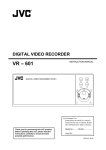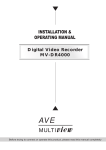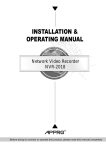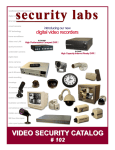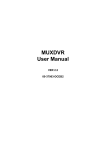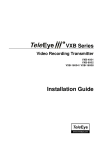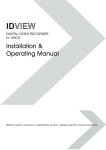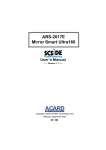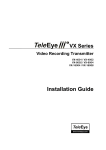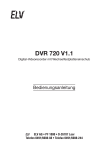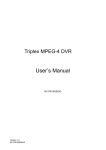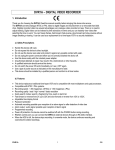Download Maxtor SLD240 User's Manual
Transcript
INSTALLATION &
OPERATION MANUAL
Digital Video Recorder
SLD240
15540 Herriman Blvd. Noblesville, IN 46060, USA
Customer support: 1-800-774-0284
www.security-labs.com
Before trying to connect or operate this product, please read this manual completely
SAFETY PRECAUTIONS
All of the following safety and operating instructions should be carefully read before this unit is
operated to prevent harm or damage to the user and other persons.
WARNING
To reduce the risk of fire or electrical shock, do not expose this appliance to rain or moisture.
Do not block ventilation openings.
Do not place anything on top of the unit that might spill or fall into it.
Do not attempt to service this unit yourself as opening or removing covers may expose you to
dangerous voltages or other hazards. Please refer all servicing to qualified personnel.
Do not use liquid cleaners or aerosols for cleaning.
To prevent fire or electrical shock, do not overload wall outlets or extension cords.
This unit must be grounded to reduce the risk of electrical shock.
CAUTION
Danger of explosion if the Lithium battery (RTC Battery) is incorrectly replaced.
Replace only with the same or equivalent type recommended by the manufacturer.
Dispose of used batteries according to the battery manufacturer’s instructions.
INFORMATION
This equipment has been tested and found to comply with the limits for a Class A digital device,
pursuant to Part 15 of the FCC Rules. These limits are designed to provide reasonable protection
against harmful interference when the equipment is operated in a commercial environment. This
equipment generates, uses, and can radiate radio frequency energy. If not installed and used in
accordance with the instruction manual, it may cause harmful interference to radio
communications.
Operation of this equipment in a residential area can cause harmful
interference in which case the user will be required to correct the interference at his own
expense.
1
Table Of Contents
1. INTRODUCTION......................................................................................................................... 4
1.1 Overview ....................................................................................................................................4
1.2 Product Features........................................................................................................................4
2. DESCRIPTION OF THE FRONT/REAR VIEW ...................................................................... 5
2.1 Front View..................................................................................................................................5
2.2 Rear View ...................................................................................................................................7
2.3 ALARM In/Out...........................................................................................................................8
3. INSTALLATION ........................................................................................................................... 9
3.1 Basic Connection .......................................................................................................................9
3.2 Hard Disk Drive Installation ...................................................................................................12
3.3 System Information ..................................................................................................................13
3.4 Updating System Software .......................................................................................................14
4. BASIC OPERATIONS .............................................................................................................. 15
4.1 Configure Recording Settings..................................................................................................15
4.3 Playback Operations................................................................................................................21
4.4 Search Operations....................................................................................................................23
4.5 Data Backup.............................................................................................................................26
4.6 Key Lock Operation.................................................................................................................29
5. MENU SETUP............................................................................................................................ 30
5.1 REC SETTING .........................................................................................................................31
5.2 ALARM SETTING....................................................................................................................32
5.3 CLOCK / TIMER......................................................................................................................35
5.4 COMMUNICATION................................................................................................................36
5.5 DISK SETTING........................................................................................................................39
5.6 SYSTEM ...................................................................................................................................40
2
6. IDE HARD DISK INSTALLATION .......................................................................................... 43
6.1 Built-in Hard Disk ....................................................................................................................43
6.2 Mobile Rack .............................................................................................................................44
7. SYSTEM DEFAULT .................................................................................................................. 47
8. O.S.D MESSAGE ...................................................................................................................... 49
9. NETWORK CONFIGURATION............................................................................................... 50
9.1 Cable Connections...................................................................................................................50
9.2 Configure Your DVR Network Settings ....................................................................................53
9.3 TCP/IP Communication Software ............................................................................................54
9.4 TCP/IP Installation..................................................................................................................56
9.5 TCP/IP Configuration Setting..................................................................................................57
9.6 Connection Testing ...................................................................................................................58
10. INDEX TABLE.......................................................................................................................... 60
11. NETWORK VIEWER AND IMAGE VIEWER ...................................................................... 61
11.1 The Network Viewer ...............................................................................................................61
11.2 The Image Viewer...................................................................................................................69
11.3 Internet Browser Viewer .........................................................................................................70
12. RS-232 & RS-485 PROTOCOL............................................................................................ 71
12.1 Setup.......................................................................................................................................71
12.2 Communication Protocol.......................................................................................................72
13. COMPATIBLE MULTIPLEXER DRIVES............................................................................. 75
14. SPECIFICATIONS................................................................................................................... 76
3
1. Introduction
1.1 Overview
The DVR, model SLD240, is a storage media of digital video images, which uses hard disk drives
instead of VCR tapes to store video. It enables you to enjoy the extreme flexibility of digital image
archiving instead of clumsy tape management, and it is compatible with most multiplexers on the
market. With a wide range of comprehensive features, such as playback picture -by-picture, quick
search by time and event, an Ethernet connection for remote viewing, the upgradeable software of the
system, the expandable capacity of the hard drive, and much more, the DVR makes your applications
far more flexible and effective than ever before. The DVR is going to prove to be the timely substitute
for the Time-lapse VCR.
1.2 Product Features
*
Stores video in hard disk drives instead of VCR tapes.
*
Maximum of 2 hard disk drive capability. (One removable)
*
Hard disk drive hot-swapping capability.
*
Pre-alarm image recording.
*
Capable of working with various known multiplexers.
*
Time-lapse and real-time recording.
*
Refresh rate up to 60 FPS.
*
Image quality selectable at 4 different levels for recording.
*
Event/Timer/Alarm recording mode.
*
Quick search by time, alarm, event, and recording list.
*
Fast and slow playback of recorded video at various speeds.
*
Single-picture playback.
*
On-screen setup menu, title, and system timer.
*
Password protection.
*
Motion detection.
*
Disk-full warning and operation status LEDs.
*
RS-232 and RS-485 communication ports.
*
Remote control via RS-232, RS-485, and Ethernet ports.
*
Power interruption recovery.
*
Operation-status record log.
*
Distribution of live and recorded images through TCP/IP network environment.
*
Audio function included.
*
Built-in SD card slot for copying images to an SD card.
*
Supports DHCP protocol.
4
2. DESCRIPTION OF THE FRONT/REAR VIEW
2.1 Front View
1
2
19
18
17
DISK
A-rec
T-rec
20
21
SD Card
22
Power
Monitor
Display
Search
Setup
Enter
7
16
8
10
9
15
13
12
11
14
Play
Pause
Stop
Rec
4
3
5
6
Hard Disk Drive Compartment.
This compartment allows you to install a hard disk drive mostly for backup purposes. Make sure the
drive is well secured with the mounting screws in the mobile rack before you put the rack into the
compartment.
Hard Disk Compartment Lock:
The key lock secures a hard disk in place. Unlock the compartment before you remove the hard
disk rack from the slot while the DVR is still on. After the hard disk rack is placed back in the slot, it
must be locked to activate the hard disk drive.
PAUSEbutton:
During video playback, press this button to freeze the display. During the freeze, press this button
to display one frame/field of a picture at a time in the forward direction . (Button i lluminates green in
PAUSE mode.)
PLAY button:
Press to play back recorded video from the hard disk. (Button illuminates green in PLAY mode.)
STOP button:
Press to stop playing back video or recording video onto a hard disk. (Button illuminates green in
STOP mode.)
REC button:
Push to start recording video onto a hard disk while in the live display mode. (Button illuminates
red in REC mode.)
POWER button:
Press and hold this button for at least 3 seconds to power off. Press again to activate the device.
5
DISPLAY button:
Press to show the system operation status on the screen.
Setup button:
Press this to enter the setup menu. Press again to exit the setup mode.
Search button:
Press to enter the search mode to access recorded video.
Left / Right buttons:
Press these two buttons to highlight desired items in the menu setup mode. For Key Lock
operation, press and hold these two buttons simultaneously for at least 3 seconds; to disable
Key Lock, press these two buttons simultaneously again.
Up / Downbuttons:
Press these two buttons to select the desired contents for programming in the setup menu mode.
Enter Button:
Press to enter a selected item and save the setting in the menu setup mode.
Monitor button:
Press to switch between a multiplexer-decoded video and the encoded video to be displayed
when connected with a multiplexer. When the button light is on, it indicates the unit is displaying
the decoded video. (The images are not multiplexing.) In this mode, the unit does not display the
OSD message of the unit on the screen. However, this does not affect the unit’s OSD message
which is recorded onto hard disk drives. When the button light is off, it indicates the unit is
displaying encoded video. (The images switch swiftly).
T-rec Indicator:
This indicator of the timer recording mode lights up to signal the scheduled record setting is on.
A-rec Indicator:
This indicator of the alarm recording mode lights up to signal the a larm record setting is on.
DISK Indicator:
This indicator shows the operation status of the unit’s hard disk drives. The green light indicates
the hard disk drive is storing or retrieving data. The red light signals the hard disk drive is filling up.
The orange light indicates the hard disk is retrieving at disk-full status.
Shuttle Ring:
The shuttle can be moved forward and backward for playback in either direction. Turn this
counterclockwise to play a recorded video in the reverse direction at faster or slower speeds
than the recorded speed. Turn this clockwise to play a recorded video in the forward direction at
faster or slower speeds than the recorded speed.
Jog Dial:
This dial can act in both a forward and a backward direction, as well as step by step. Turn this
counterclockwise to play a recorded video in the reverse direction. Turn this clockwise to play a
recorded video in the forward direction.
SD CARD Slot:
This is used for system software updating and archiving/ accessing critical images.
6
2.2 Rear View
25 26 27
28
29
31
FROM MUX
MAIN MONITOR
VIDEO
AUDIO
IN
32
ETHERNET
10/100
RS-232
OUT
OUT
TO
MUX'S VCR IN
RS-485
IN
TO
MONITOR
ALARM
33 34
I/O
35
DC12V
37 38 36
VIDEO IN Connector: This BNC connector is used to connect the video output from a camera or a MUX
(multiplexer) to the DVR.
FROM MUX MAIN MONITOR Connector: This BNC connector is used to connect the live video output
from a MUXto the DVR.
AUDIO IN Connector: This connector is used to connect the audio output from a camera, a MUX, or
other audio device to the DVR.
ETHERNET 1 0/100 Connector: This is one standard RJ-45 connector for 10/100 Mbps Ethernet
networks.
RS-485 Port: The RS-485 communication ports function as connectors when two or more units are
connected in series to expand the storage capacity.
RS-232 Port: The RS-232 communication port functions as a connector to an external control device.
Please refer to for more details.
VIDEO OUT Connector: This connector provides the unit’s composite video signal to a MUX.
MONITOR Connector : This connector provides the unit’s composite video or a MUX’s live signal if
connected to a display device.
AUDIO OUT: This provides the unit’s audio signal to a speaker.
ALARM I/O: This is a 9-PIN D -SUB connector including SWITCH OU T, GROUND, ALARM OUT, DISK
FULL, RECORD IN, ALARM R ES ET, and A LARM IN for connecting with external devices. Please refer
to the next section (2.3) for details.
Plug Inlet: The i nlet connects to an external power supply. Connect a 12 Vdc UL Listed Class 2 or ITE
LPS Power Supply.
Wire Catch: The wire catch secures the power cord and keeps it in place (so that it does not droop or
hang loosely).
Ground Screw: Screw used to ground the chassis.
7
2.3 ALARM In/Out
DISK FULL
ALARM RESET
ALARM OUT
RECORD IN
GROUND
5
4
9
3
8
2
7
1
6
ALARM IN
SWITCH OUT
NO CONNECTION
NO CONNECTION
THIS FIGURE IS FROM THE REAR VIEW
1.
GROUND: Ground Contact.
2.
A LARM OUT (OUTPUT): This is an alarm output trigger. Connect this to external devices such
as buzzers or lights. (
3.
5V
0V(Active)
)
5V
0V(Active)
)
REC ORD (INPUT): This pin connects to a record trigger device for starting a record.
(
6.
)
A LARM RESET (INPUT): This pin connects to an alarm-clear device for clearing an alarm.
(
5.
0V(Active)
DISK FULL (O UTPUT): This is a disk full output trigger. Connect this to external devices such
as buzzers or lights. (
4.
5V
5V
0V(Active)
)
SWITCH OUT (OUTPUT): This pin sends out timing signals (falling / negative) to a multiplexer
and connects to a multiplexer’s trigger terminal so the multiplexer can switch to use the same
recording speed as the DVR. (Refer to Section 4.1.1 for multiplexer configuration.)
7.
NO CONNECTION
8.
NO CONNECTION
9.
A LARM IN (INPUT): This is an alarm input which can be programmed in the menu system to
5V
Normally Open or Normally Closed. (
0V(Active)
8
)
3. INSTALLATION
Please follow the instructions and the diagrams below to set up the system.
3.1 Basic Connection
CONNECTING WITH A SINGLE CAMERA
Please set the MULTIPLEXER option to OFF on the REC SETTING page in the setup menu when
it is connected with a single camera. (Please refer to Section 5.1 MULTIPLEXER option)
Camera
FROM MUX
MAIN MONITOR
VIDEO
AUDIO
IN
RS-485
IN
ETHERNET
10/100
OUT
OUT
TO
MUX'S VCR IN
RS-232
TO
MONITOR
ALARM
I/O
DC12V
Monitor
CONNECTING WITH A MULTIPLEXER
To match the multiplexer’s recording speed, please set the MULTIPLEXER option to ON in the REC
SETTING page in the setup menu when it is connected with a multiplexer. (Please refer to Section
5.1 MULTIPLEXER for the multiplexer option and Section 4.1.1 for configuration.)
CONNECTING WITH A QUAD
Please set the MULTIPLEXER option to OFF on the REC SETTING page in the setup menu when
it is connected with a quad . (Please refer to Section 5.1 MULTIPLEXER for the multiplexer option
and Section 4.1.1 for configuration.)
9
Multiplexer
IN
Audio
OUT
Tr ig In
PC
S-v ideo
FROM MUX
VIDEO
MAIN MONITOR
AUDIO
IN
RS-485
IN
ETHERNET
10/100
OUT
OUT
TO
MUX'S VCR IN
RS-232
TO
MONITOR
ALARM
Monitor
I/O
DC12V
Speaker
GROUND
SWITCH OUT
5
4
9
3
8
2
7
1
6
For more information on configuration, please refer to Section 4.1.1
Quad
IN
Audio
OUT
PC
S-vi deo
FROM MUX
VIDEO
MAIN MONITOR
AUDIO
IN
RS-485
IN
ETHERNET
RS-232
10/100
OUT
OUT
TO
MUX'S VCR IN
TO
ALARM
MONITOR
Monitor
Speaker
10
I/O
DC12V
ATTACHING AN EXTERNAL DEVICE TO THE DVR
Connect an alarm out, alarm input, or a peripheral device as shown in the diagram below.
Lamp
VIDEO
FROM MUX
MAIN MONITOR
AUDIO
IN
RS-485
IN
ETHERNET
10/100
RS-232
OUT
OUT
TO
MUX'S VCR IN
TO
MONITOR
ALARM
I/O
DC12V
Alarm Reset
(Normally Open)
5
Ground
4
9
Alarm in
(Normally Open)
11
3
8
2
7
1
6
3.2 Hard Disk Drive Installation
The DVR is equipped with two compartments for hard disk drives. The unit usually comes with one hard
disk drive installed in the compartment HD1, which is default-configured as a master. If you need a
second hard disk drive, it should be installed in the compartment HD2 (Mobile). If there is only one
hard disk drive, and it is in the mobile compartment, please set the HD2 USAGE option to REC (Please
refer to Section 5.5) before proceeding to record. The jumper-settings arrangement of installed hard
disk drives for the system (Table 3.2 A.) is shown in the tables below.
Table 3.2 A. The jumper settings of hard disk drives in the system
Location
Jumper
IDE 1
Compartment HD 1
Master (Default)
IDE 2
Compartment HD 2
Master
Table 3.2 B. Compatible hard disk drives
Manufacturer
Western Digital
Model
Capacity
Rotation
80GB
5400 RPM
120GB
5400 RPM
80GB
7200 RPM
WD1200BB
120GB
7200 RPM
WD1800BB
180GB
7200 RPM
80GB
5400 RPM
WD800AB
WD1200AB
WD800BB
Seagate
ST380020A/P
ST340810A/P
Maxtor
40GB
5400 RPM
160GB
5400 RPM
4R080L0-1
80GB
5400 RPM
6Y120L0-1
120GB
7200 RPM
6Y200P0-1A
200GB
7200 RPM
6Y250P0-1A
250GB
7200 RPM
4A160J0-1A
NOTE: Hard disk drives not shown on this list have not been tested by the engineering team.
Alternate hard drives may work in this unit, but are not recommended unless instructed
by customer service. For an updated list of the recommended hard disk drives, please
contact customer service.
12
3.3 System Information
You can display system settings information as shown on Table 3.3 A below at any time by pressing the
Display button
. In playback mode, the recorded video information is displayed. In the live or
recording mode, the Manual Recording information is displayed. However, when the DVR is displaying
a decoded image from a multiplexer, you must first switch the unit to the encoded image display (The
pictures are switching swiftly and the light of Monitor button
. Each sequen tial press of the Display button
is off) by pressing the Monitor button
displays a different message detailed in the
following example. By default, the unit displays time, date, and an indicating bar of hard disk capacity
status on a monitor as shown next.
Default display
(Capacity Used)
(Capacity Remaining)
09- 05-2003
16:13:02
(Date)
(System Time)
Press the Display button
once; the DVR will display the following sample message plus the default
display. Press the Display button
again; the unit will not display any OSD message. Press the
button one more time to return to the default display.
Table 3.3 A.
Description of Table 3.3 A
(1+2: 59G): Total capacity of installed hard disk, 59 GB
(12.4 HR): Total 12.4 hour recording time available
1+ 2: 59G
(
): Timer record activated
NTSC
(
): Alarm record activated
20 F/S
(QUALITY: BEST): Record quality setting, BEST
12.4 HR
QUALITY: BEST
MUX : OFF
(NTSC): NTSC system
9K
(20 F/S): Record speed setting, 20 fields/sec
(MUX: OFF): Only connected to a single camera
(
HD
1
2
P
Y
Y
SIZE
): Audio function activated
POS
(
20 G
39.5% P
(9K): The image file size
39 G
0.0% R
(HD): Hard disk compartment
IP : 192 . 168 . 1 . 90
): Indicate which HDD is activated
(P): Y Hard disk installed; . No hard disk installed
(SIZE 20G): The capacity of the installed hard disk
(POS): Percentage of system; R: Recording; P: Playback
(IP : 192 . 168 . 1 . 90): IP Setting of the Ethernet
communication
( ): External signal
(
X): System Busy: Command not received
13
3.4 Updating System Software
If the system software of the DVR needs o
t be upgraded, please take the following steps to safely
update it.
Important: Before carrying out the following procedures, please ensure the SD card is working
and the software system file on the SD card is intact.
1. Turn off the DVR.
2. Insert the SD card into the built-in SD slot on the front of the unit.
3. Press and hold the
Up and
Downbuttons simultaneously, and then turn on the unit.
4. Keep holding down the buttons until the DVR sounds a tone and display the message “ XXXXXX
BYTES READ” Now the DVR is updating the system software, which will take approximately 90
seconds to process.
5. Restart the unit when the device sounds a tone twice and displays the message “ PLEASE RESTART”
The process is complete.
(If you have followed the procedures 1-5 and the unit is not able to power on, please check if the SD
card you are using is functioning and the file is intact.
After this has been completed, start
procedures 1 - 5 over again.)
6. Verify the version of the system software. (Please refer to Section 5.6 VERSION option)
DISK
A-rec
T-rec
SD Card
Power
Monitor
Display
Search
Setup
Enter
Play
13
Pause
Stop
12
Warning: Don’t interrupt the process while the unit is updating itself or insert an SD card that
contains no updated software. If these instructions are not followed, the system may
freeze.
14
Rec
4. BASIC OPERATIONS
This section shows you how to operate and manage the DVR.
4.1 Configure Recording Settings
Recording Time settings (Recording Rate and Picture Quality Setting)
Recording time will vary depending on the image size, recording rate, and the capacity of th e hard disk
drives. Generally, the DVR comes with a built-in hard disk drive for continuous recording from one to four
weeks under most recording conditions. Table 4.1.2 shows the possible recording times based on an
80GB hard disk drive at certain refresh rates and the corresponding image quality. With one or more
hard disk drive(s) in operation, please calculate the necessary recording time using the table below. For
example, if the unit is set to record images with BEST quality at a 60 fps record rate, n ormally an 80GB
hard disk drive will be filled in 15 hours (See the gray area in the table). If a 240GB hard disk drive is in
use under the same refresh rate and picture quality, it will be filled in 45 hours ( 3 times the rate of an
80GB hard disk drive).
Set up the REC Time Mode when a multiplexer is connected
If a multiplexer is connected, for optimum image recording and playback, the record speed of the
multiplexer must be correctly adjusted to match the DVR and set the MULTIPLEXER option on the
setup menu to ON. This can be done by the method detailed below.
4.1.1 Multiplexer Setup
Connect the SW. OUT terminal i n 9-PIN D-SUB connector on the rear panel of the DVR to the
multiplexer’s trigger contact. The DVR will provide the timing signal to the multiplexer.
Note: The DVR will only send out a timing signal while it is in RECORD mode.
In the multiplexer’s menu, set the recording mode to SYNC for recording in all DVR refresh rates except
60fps and 30fps.
In SYNC mode, if the DVR changes the recor ding speed, the multiplexer will
automatically adjust the recording to match. Be sure to set your multiplexer’s timing signal to falling. If
you wish to record in 60fps or 30fps, put the multiplexer in real-time instead of SYNC. 60fps and 30fps
timing signals are constantly negative/falling.
15
Table 4.1.2
MUX ON
Audio ON
BEST
Image
HIGH
Quality
STANDARD
BASIC
Refresh Rate (Field/Sec)
26.8
33.4
44.4
66.1
60
30
20
15.0
18.0
22.5
30.1
18.0
22.5
30.1
45.1
27.1
33.8
45.1
67.7
60
30
20
MUX ON
Audio OFF
BEST
Image
HIGH
Quality
STANDARD
BASIC
Refresh Rate (Field/Sec)
MUX OFF
Audio ON
BEST
Image
HIGH
Quality
STANDARD
BASIC
Refresh Rate (Field/Sec)
35.6
44.4
58.9
87.4
60
30
**20
15.0
18.0
22.5
30.1
18.0
22.5
30.1
45.1
36.1
45.1
60.2
90.3
60
30
**20
MUX OFF
Audio OFF
BEST
Image
HIGH
Quality
STANDARD
BASIC
Refresh Rate (Field/Sec)
Possible Recording Time HDD=80GB ( hour )
44.4
95.8 208.5 380.6 598.5
55.3 118.8 255.7 459.6 708.9
73.2 156.1 330.5 580.0 869.5
108.4 227.6 467.3 785.9 1124.0
12
5.5
2.4
1.22
0.71
1/4
Possible Recording Time HDD=80GB ( hour )
45.1
99.3 225.9 442.7 768.0 2177.7
56.4 124.2 282.3 553.4 960.1 2722.1
75.3 165.6 376.5 737.9 1280.1 3629.5
112.9 248.4 564.7 1106.9 1920.2 5444.3
12
5.5
2.4
1.22
0.71
1/4
1/6
1/8
3262.0
4077.6
5436.8
8155.2
4346.4
5433.0
7244.0
10866.1
1/6
1/8
1/6
1/8
3271.1
4088.9
5451.8
8177.8
4355.4
5444.3
7259.1
10888.6
1/6
1/8
Possible Recording Time HDD=80GB ( hour )
53.1 104.2 216.2 387.2 603.9
66.1 129.0 264.9 467.3 715.1
87.4 169.4 342.1 589.3 876.4
129.0 246.4 482.7 797.3 1131.7
**12
**5.5
2.4
1.22
0.71
1/4
Possible Recording Time HDD=80GB ( hour )
54.2 108.4 234.9 451.8 777.1 2186.7
67.7 135.5 293.6 564.7 971.3 2733.4
90.3 180.7 391.5 753.0 1295.1 3644.6
135.5 271.0 587.3 1129.5 1942.7 5466.9
**12
**5.5
2.4
1.22
0.71
1/4
NOTE: Recording times on the tables above are estimated.
NOTE: No audio function available at refresh rates: 60 fields/sec, 30 fields/sec, 1/4
fields/sec, or 1/8 fields/sec.
** : For MUX Off Mode, recording rate 20F/S would actually be 15 F/S, 12F/S would be
10 F/S, and 5.5 F/S would be 5F/S.
(This adjustment is to avoid image shaking during playback at the same speed.)
16
4.2 Record ing Operations
This section details the way to record video onto hard disk drives. Before continuing with the record
function, please configure the recording settings properly to your needs.
4.2.1 Manual Recording
When the DVR is in live display mode, take the following steps to start recording:
(1) In live display, press the REC button
to record video onto a hard disk drive with the
corresponding programmed recording settings . The monitor should display a flashing REC
message and the REC button
(2) Press the STOP button
will light up indicating the DVR is in the recording status.
to stop recording any time.
(3) To access the most recent video, press the PLAY button or refer to Section 4.4 for more details.
4.2.2 Timer Recording
Timer recording provides two periods of time each day in a weekly table which programs the DVR to
turn on and o ff at specified times. This way the DVR will start and stop recording according to the
programmed schedule. Please take the following steps to program the scheduled recording.
(1) Press the Setup button
to enter the MAIN MENU.
(2) Select the CLOCK / TIMER and p ress the Enter button
to enter the CLOCK / TIMER page.
(3) Select the TIMER followed by SET.
(4) Press the Enter button
to enter the REC SCHEDULE table.
(5) You can set by using the “<” button
day/hour/minute and use the “^” button
a.
and the “v” button
,
is the equal of the “>” button
is the equal of the “v” button
,
to locate the specific
to set the day/hour/minute.
You can also set by using the Shuttle Ring and the Jog Dial.
button
b.
and the “>” button
is the equal of the “<”
is the equal of the “^” button,
and
.
The time is displayed in a 24-hour clock format.
(6) After scheduling is completed, press the Enter button
and set OK to save the setting or
select CANCEL to leave the page without saving the settings.
(7) To activate the programmed recording schedule, set the REC ENABLE to ON . As the
scheduled recording is on, the red indicator of the Timer Record
will be on as well. To
deactivate it, set to OFF.
(8) Press the STOP button
during the scheduled recording to stop it at any time. If you wish to
continue the scheduled recording, press the REC button
to proceed.
NOTE: You can proceed to start the scheduled recording from the current time if it is in the
scheduled interlude as soon as setting is completed, and you exit the menu.
NOTE: If you activate the recording function before the scheduled recording, the unit will record
as shown in the diagram below and keep those images in different files.
17
START
END
06:00
08:00
03:00
Start Manual
Recording
Timer
START
END
12:00
Manual
MAIN MENU
14:00
Timer
Manual
MAIN MENU
RECORD
ALARM
CLOCK / TIMER
COMMUNICATION
DISK
SYSTEM
RECORD
ALARM
CLOCK / TIMER
COMMUNICATION
DISK
SYSTEM
GOTO CLOCK / TIMER PAGE
GOTO CLOCK / TIMER PAGE
CLOCK / TIMER
CLOCK
REC ENABLE
TIMER
CLOCK / TIMER
: SET
: OFF
: SET
CLOCK
REC ENABLE
TIMER
MAIN PAGE
MAIN PAGE
SET REC SCHEDULE
TIMER REC ENABLE
REC SCHEDULE
START END
S : 00:00-00:00
M: 00:00-00:00
T : 00:00-00:00
W: 00:00-00:00
T : 00:00-00:00
F : 00:00-00:00
S : 00:00-00:00
OK
TO MOVE
START END
00:00-00:00
00:00-00:00
00:00-00:00
00:00-00:00
00:00-00:00
00:00-00:00
00:00-00:00
CANCEL
TO CHANGE
18
: SET
: OFF
: SET
4.2.3 Alarm Recording
Take the following steps to activate the programmed alarm recording. For ALM OPERATION, REC
RATE, REC QUALITY, AUDIO , ALM TYPE, ALM DURATION, and PRE-ALARM settings, please
refer to Section 5.2 for more details.
(1) Press the Setup button
to enter the MAIN MENU.
(2) Select ALARM and press the Enter button
to enter the ALARM SETTING.
(3) Set the desired REC RATE, REC QUALITY, ALM TYPE, and ALM DURATION for use. If audio
is required, set AUDIO to ON. If pre-alarm recording is required, set PRE-ALARM to ON.
(4) To activate the alarm recording, set ALM OPERATION to ON. To deactivate it, set ALM
OPERATION to OFF.
MAIN MENU
ALARM SETTING
ALM OPERATION
: OFF
REC RATE
: 20F/S
REC QUALITY
: BEST
AUDIO
: OFF
ALM TYPE
: NO
ALM DURATION
: 0 SEC
PRE- ALARM
: OFF
MOTION SETTING
RECORD
ALARM
CLOCK / TIMER
COMMUNICATION
DISK
SYSTEM
MAIN PAGE
ALARM REC ENABLE
GOTO ALARM PAGE
(5) To activate the motion alarm recording, select MOTION SETTING and press the Enter button
to enter the MOTION SETTING PAGE. Set MOTION ENABLE TO ON, and set the sensitivity
level that will trigger motion alarm recording. (1 is most sensitive; 5 is least sensitive).
ALARM SETTING
MOTION SETTING
ALM OPERATION
: OFF
REC RATE
: 20F/S
REC QUALITY
: BEST
AUDIO
: OFF
ALM TYPE
: NO
ALM DURATION
: 0 SEC
PRE- ALARM
: OFF
MOTION SETTING
MOTION ENABLE
SENSITIVITY
: ON
:3
?
MAIN PAGE
MAIN PAGE
ALARM REC ENABLE
SET MOTION DETECTION
19
4.2.4 Externally triggered Re cording
By connecting the RECORD IN of ALARM I/O on the rear panel of the DVR, you can
activate/deactivate the recording function of a DVR. The file will be kept with a prefixed “R”. Please
refer to Section 2.3 for more details.
NOTE: The status of recording operations when an alarm takes place are shown in the
diagrams below .
1
Manual or Externally
Triggered Recording
Alarm Takes Place
Actual Recording
Speed
2
Normal
Alarm
Normal
Normal
Alarm
Normal
Timer Recording
Alarm Takes Place
Actual Recording
Speed
3
Timer Recording
Alarm Takes Place
Actual Recording
Speed
4
Normal
Alarm
Timer Recording
Alarm Takes Place
Actual Recording
Speed
Alarm
Normal
20
4.3 Playback Operations
This section shows you how to operate the fast, slow, and single picture playback functions, and details
how the unit is to playback a file in a different operation status. Please refer to the following paragraphs
specifying the relevant details. When playing a file, the monitor should display a flashing PLAY message
and the PLAY button
will light up indicating that the DVR is in the playback status.
Operation Status
A. From REC Mode to Playback Mode
(In live mode, directly press the PLAY button
to play a latest recorded video)
In recording mode, press the stop button. Press play to play back the video just recorded.
B. Search to Play Back a Particular Recorded Video
For this type of playback, refer to Section 4.4.
C. Play Back from the Oldest Data
Press and hold the stop button for 3 seconds. The “Stop” indicator will appear on the top right side of the
screen. To play the oldest video, press PLAY.
4.3.1 Fast Forward/Reverse
There are 7 speeds available for playback: 1x, 2x, 4x, 8x, 16x, 30x and 100x
While playing back recorded video at recorded speed:
Forward: Turn the Shuttle dial
clockwise to view the rec orded video in the forward direction at a
speed faster than the recorded speed. Each subsequent turn of the shuttle clockwise increases
the forward rate, as 2x, 4x, 8x, 16x, 30x and 100x.
Reverse: Turn the Shuttle dial
counterclockwise to view the recor ded video in the reverse direction
at a speed faster than the recorded speed. Each subsequent turn of the shuttle to the
counterclockwise increases the reverse rate , as -1x, -2x, -4x, -8x, -16x, -30x and -100x.
Normal:
Release the Shuttle dial
to return to the normal speed of playback.
* You can also operate by using “<” button
and “>” button
.
NOTE: When playing a recorded video through a multiplexer at 60 F/S or 30F/S, the playback
speed is half of the recorded speed.
NOTE: The playback speed will be displayed on the screen. However, when playing a recorded
video from a multiplexer, the playback speed will only display in encoding (multiplexing)
mode. Press the Monitor button
to switch between decoding and encoding modes.
21
4.3.2 Slow Forward/Reverse
There are 4 speeds available for a slow playback: 1/2, 1/4, 1/8, 1/16. While playing back recorded video
at the recorded speed:
(1) Press the PAUSE button
for the slow playback mode.
(2) Forward: Turn the Shuttle dial
clockwise to view the recorded video in the forward direction
at a speed slower than the recorded speed. Each subsequent turn of the shuttle to the right
increases the forward rate, as 1/2, 1/4, 1/8, and 1/16.
(3) Reverse: Turn the Shuttle dial
counterclockwise to view the recorded video in the reverse
direction at a speed slower than the recorded speed. Each subsequent turn of the shuttle to the
left increases the reverse rate, as -1/2, -1/4, -1/8, and -1/16.
(4) Normal:
Release the Shuttle dial
and then press the PLAY button
to return to the
normal speed of playback.
* You can also operate by using “<” button
and “>” button
.
4.3.3 Play Back Picture-by-Picture
While playing back recorded video at the recorded speed:
(1)
(2)
Press the PAUSE button
for the picture-by-picture mode.
There are two ways, by PAUSE button or by JOG, available to play in the picture-by-picture
mode, but the PAUSE button
can only function in a forward direction; the other, JOG dial
, can act in both a forward and a backward direction, as well as picture-by-picture.
By PAUSE button
:
Press the PAUSE button
to display one frame/field of a picture at a time in the
forward direction. (When playing back video recorded by a multiplexer, each
sequential press of the PAUSE button
By JOG dial
will display each camera in sequence.)
:
Turn the JOG dial
clockwise to display one frame/field of a picture at a time in the
forward direction. Turn the JOG dial
counterclockwise to display one frame/field of a
picture at a time in the backward direction.
(3) Press the PLAY button
to return to the normal speed of playback.
4.3.4 Play Back Recorded Video from an HDD in the Mobile Rack
To play back a recorded video from HD 2, take the following steps:
(1) Press the Setup button
to enter the setup menu.
(2) Select DISK and press the Enter button
to enter the DISK SETTING page.
(3) Set the HD2 USAGE to REC and then exit the setup menu.
(4) Use the search function to access desired recorded video. For specific operation details please
refer to Section 4.4 (Search Operations ).
22
4.4 Search Operations
This section shows you how to access recorded video.
4.4.1 Full List Search
Take the following steps to proceed with the full-list search function.
(1) Press the Search button
to enter the search mode.
(2) Select the FULL LIST and press the Enter button
to access the complete list of recorded
video.
(3) Highlight the specific recorded video you wish to view and press the Enter button
to display
the selected video.
(Key Operation: Press the
and
“^” and
“v” buttons, to select a video; press the
“<”
“>” buttons, to flip over a page.)
SEARCH
A
FULL LIST
ALARM LIST
TIME SEARCH
THUMBNAIL
SD CARD
R
T
HD 1
1 11-11-02
2 11-18-02
3 12-02-03
4 01-02-03
5 02-14-03
6 02-17-03
7 02-20-03
8 02-27-03
12:20:23
13:30:16
14:20:25
17:20:46
16:11:55
13:30:22
18:33:54
19:21:12
10.1M
2.34M
2.05M
5.32M
24. 2M
36. 6M
6.41M
92. 3M
NOTE: T: Timer recording; R: External trigger recording; A: Alarm recording.
NOTE: The maximum number of lists, for a respective HDD, is 3,000.
4.4.2 Alarm list Search
Take the following steps to proceed with the alarm list search function.
(1) Press the Search button
to enter the search mode.
(2) Select the ALARM LIST and press the Enter button
to access the complete list of
alarm-event recorded video.
(3) Highlight the specific recorded video and press the Enter button
(Key Operation: Press the
“^” and
to display the selected video.
“v” buttons, to select a video; press the
“<” and
“>” buttons, to flip over a page.)
HD 1
SEARCH
23
A
A
1 11-18-02 13:22:16 16. 3M
2 02-14-03 16:55:45 15. 6M
4.4.3 TIME Search
Take the following steps to proceed with the time-list search function.
(1) Press the Search button
to enter the search mode.
(2) Select the TIME SEARCH and press the Enter button
to access the time-setting page.
(3) Set the time period you wish to search for the recorded video.
(4) Press the Enter button
to start searching and displaying the concerned image.
(5) If no video is found, please return to the time-setting page and repeat steps (3) and (4) again for
another search.
TIME SEARCH
SEARCH
MM DD YEAR HH
MM
11 / 17 / 2002 00 : 00
FULL LIST
ALARM LIST
TIME SEARCH
THUMBNAIL
SD CARD
4.4.4 THUMBNAIL Search
Take the following steps to proceed with the time list search function.
(1) Press the Search button
to enter the search mode.
(2) Select the THUMBNAIL and press the Enter button
to access the thumbnail page.
(3) Set the date you wish to search for the recorded video.
(4) Press the Enter button
a.
You can set by using the “<” button
button
b.
to start searching and displaying the specific images.
, the “>” button
, the “^” button
and the “v”
to move eye focus .
You can also set by using the Shuttle Ring and the Jog Dial to move eye focus .
equal of the “<” button
button
and
,
is the equal of the “>” button
is the equal of the “v” button
24
.
,
is the
is the equal of the “^”
(5) There are 5 levels of recording range modes to choose from: 1 Hour, 10 Minutes, 1 Minute, 10
Seconds and 1 Second. Select the specific field and press the Enter button
to enter the next
level. If you want to return to the previous level, please press the Setup button.
(6) Once you reach the critical point at any level, the user can start playback by just clicking the
PLAY button
.
THUMBNAIL
SEARCH
MM DD YEAR
03 / 13 / 2003
FULL LIST
ALARM LIST
TIME SEARCH
THUMBNAIL
SD CARD
4.4.5 SD CARD Search
Take the following steps to proceed with the time-list search function.
(1) Insert an SD Card into the SD card slot on the front of the unit.
(2) Press the Search button
to enter the search mode.
(3) Select the SD CARD and press the Enter button
to access the complete list of JPG files .
(4) Highlight the specific JPG file and press the Enter button
to display the image.
(5) If you need another, please return to the SD card JPG file list page and repeat steps (3) and (4)
again for another search.
SD CARD JPG FILE
SEARCH
F0000.JPG
F0001.JPG
F0002.JPG
F0003.JPG
F0004.JPG
F0005.JPG
FULL LIST
ALARM LIST
TIME SEARCH
THUMBNAIL
SD CARD
NOTE: If you would like to delete a JPG file in the SD card, please return to SD CARD JPG FILE list
page and highlight the specific JPG file and press the Setup button
“Yes” to delete the image.
25
and then select the
4.5 Data Backup
4.5.1 Mobile Rack HD Backup Operations
There are three ways available to duplicate the recorded video from HD 1 (Fixed HD) to HD 2 (Mobile
Rack HD). Please take the following steps to proceed.
Set HD 2 to BACKUP first. Take the following steps.
?? Press the Setup button
to enter the setup mode and select the DISK.
?? Highlight DISK and press the Enter button
to enter the DISK SETTING page.
?? Then set HD 2 USAGE to BACKUP.
MAIN MENU
DISK SETTING
RECORD
ALARM
CLOCK / TIMER
COMMUNICATION
DISK
SYSTEM
REFORMAT
HD 2 USAGE---------BACKUP
REC
BACKUP
MAIN PAGE
GOTO DISK PAGE
SET HD2 USAGE
(1) FULL: Duplicate all the recorded video from HD1 to HD2.
?? Stay on the DISK SETTING page.
?? Use the “^” and “v” buttons,
the Enter button
and
, to highlight BACKUP , select FULL, then press
to proceed.
MAIN MENU
DISK SETTING
RECORD
ALARM
CLOCK / TIMER
COMMUNICATION
DISK
SYSTEM
REFORMAT
HD2 USAGE
BACKUP----------------FULL
ALARM
SELECT
MAIN PAGE
GOTO DISK PAGE
BACKUP ALL TO HD2
(2) ALARM: Duplicate all the alarm-event recorded video from HD 1 to HD2.
?? Stay on the DISK SETTING page.
?? Use the “^ ” and “v” buttons,
press the Enter button
and
, to highlight BACKUP ; select ALARM, then
to proceed.
26
MAIN MENU
DISK SETTING
RECORD
ALARM
CLOCK / TIMER
COMMUNICATION
DISK
SYSTEM
REFORMAT
HD2 USAGE
BACKUP----------------FULL
ALARM
SELECT
MAIN PAGE
BACKUP ALARM TO HD2
GOTO DISK PAGE
(3) SELECT: Duplicate a particular recorded video from HD1 to HD2.
?? Stay on the DISK SETTING page.
?? Use the “^ ” and “v” buttons,
press the Enter button
, to highlight BACKUP, select SELECT and then
to list all the recorded video.
?? Press the “^” and “v” buttons,
Search button
and
and
, to select the desired clip and press the
to mark it.
After completing the selection, press the Enter button
MAIN MENU
to proceed.
DISK SETTING
RECORD
ALARM
CLOCK / TIMER
COMMUNICATION
DISK
SYSTEM
REFORMAT
HD2 USAGE
BACKUP----------------FULL
ALARM
SELECT
MAIN PAGE
GO TO DISK PAGE
BACKUP PART TO HD2
BACKUP TO HD 3
HD1
A 1 2001-02-01
2 2001-02-01
A 3 2001-03-02
4 2001-04-01
12:20
03:30 +
04:20 +
13:30
TOTAL: 41 M
READY TO GO
OK
CANCEL
NOTE: If the capacity of HD 2 is not sufficient to store all selected video, a warning message
“HD2 SPACE NOT ENOUGH” will be displayed on the screen. Please, insert a larger
capacity of hard disk drive and start the process all over again.
27
4.5.2 Security Digital Card (SD Card) Backup Operations
The SD card slot on the front of the unit has three functions as shown below:
1. Archive Single image Clips into SD Card
Please take the following steps to archive a specific image on an SD card.
1.
Insert an SD Card into the SD card slot on the front of the unit.
2.
Start playing back the recorded video. (When playing back recorded video made by a multiplexer, you
must get into the multiplexing mode and display picture by picture in order to select the desired image
for archiving. Press the Monitor button
Monitor button
to get into
the multiplexing mode so that the light of the
is off and the pictures are switching swiftly)
3.
Press the PAUSE button
to freeze the desired pictures.
4.
Press the Enter button
5.
The quantity of pictures that can be stored depends on the SD card capacity. You can have the saved
to save the image in the SD Card.
images printed out in any computer. The image is stored in the JPEG compressed format. If more
than one clip is stored in a SD card, file names will be assigned in sequence as shown below.
SAVE TO J0000.JPG
SAVE TO J0001.JPG
…
SAVE TO J000N.JPG
2. Backup the System setting info into SD Card.
The DVR offers a quick setup method by using an SD card. If a user wants to set many DVR
devices with the same settings, the DVR can save all of the settings in the SD card, then transfer it to
another DVR.
Save all settings onto the SD card:
??Insert an SD card into the SD card slot.
??Press the Setup button
to enter the setup mode and select the SYSTEM .
??Highlight SYSTEM and press the Enter button
to enter the SYSTEM SETTING page.
??Set SD SETUP to SAVE. Then the system setting info will auto save into SD card.
Transfer the system settings info from one the DVR to another:
??Insert the SD card which has stored the system settings info into the DVR.
??Press the Setup button
to enter the setup mode and select the SYSTEM .
??Highlight SYSTEM and press the Enter button
??
Then set SD SETUP to LOAD.
28
to enter the SYSTEM SETTING page.
MAIN MENU
SYSTEM
RECORD
ALARM
CLOCK / TIMER
COMMUNICATION
DISK
SYSTEM
OPERATION LOG
MENU BACKGND
BUZZER
PASSWORD
SETUP PWD
DEFAULT
SD SETUP
VERSION
: ENTER
:2
: ON
: SET
: OFF
: LOAD
: SAVE
: ENTER
MAIN PAGE
GOTO SYSTEM SETTING
VIEW OPERATION LOG
3. Updating System Software (Please refer to Section 3.4 for more details.)
4.6 Key Lock Operation
The Key lock operation protects the unit against unauthorized use by disabling the entire front panel
controls. Simultaneously press these two
Left and
Right buttons (as shown below ) for at least
3 seconds to lock the unit; to release the Key Lock, simultaneously press these two buttons again.
DISK
A-rec
T-rec
SD Card
Power
Monitor
Display
Search
Setup
Enter
Play
11
29
14
Pause
Stop
Rec
5. MENU SETUP
There are 6 categories for operation settings in the setup menu system as shown below. The following sections
will instruct you step by step to configure the operation settings and state each menu’s purpose and options.
Press the Setup button
to access the setup menu. Once inside the menu system, the on-screen menu
allows you to set up the key features of the unit. The functions of various buttons within the menu-setup mode
are described in the paragraphs below.
MAIN MENU
RECORD
ALARM
CLOCK / TIMER
COMMUNICATION
DISK
SYSTEM
KEY FUNCTIONS
Setup button
:
Press to enter the setup menu. Press again to exit the setup mode.
“^ ” “v” buttons
and
:
Press to select the desired item or entry for setting.
“<” “>” buttons
and
:
Press to highlight the desired option or to select the context for setting.
Enter button
:
Press to enter the selected item and to save the setting.
Shuttle Ring
:
Turn to highlight the desired option or to select the context for setting.
Jog Dial
:
Turn to select the desired item or entry for setting.
30
5.1 REC SETTING
This page allows you to set the recording rate and recording quality, and enables you to continue
recording when the disk is full.
MAIN MENU
REC SETTING
REC RATE
REC QUALITY
DISK FULL
AUDIO
MULTIPLEXER
RECORD
ALARM
CLOCK / TIMER
COMMUNICATION
DISK
SYSTEM
: 20 F/S
: BEST
: REWRITE
: OFF
: ON
MAIN PAGE
SET REC RATE
GOTO REC PAGE
REC RATE:
This option is for adjusting the number of pictures recorded per second o nto a storage disk. The
recording rate controls the frequency at which the number of video pictures can be recorded.
?
There are 11 different recording rates you can select from: 60F/S (60 Fields Per Second),
30F/S, 20F/S, 12F/S, 5.5F/S, 2.4F/S, 1.22F/S, 0.71F/S, 1 F/4S, 1F/6S, 1F/8S.
Please refer to the table in Section 4.1.2 for details on recording times.
REC QUALITY:
This option determines the image quality to be recorded. The DVR stores images in the
compressed format and allows the image quality to be altered by the image size. There are 4 levels
of image quality you can select from: BEST, HIGH, STANDARD, and BASIC. Selecting the BEST
image for use provides higher-resolution recorded images, and normally takes up more storage
space than a HIGH, STANDARD or BASIC image does.
DISK FULL:
This option determines the way to utilize storage media in case of a full disk.
REWRITE: When the hard disk is full, the device continues recording by displacing the old data.
STOP: When the hard disk is full, the device will stop recording.
31
AUDIO:
This option determines the way to record sound if necessary.
ON: Enables AUDIO recording.
OFF: Disables AUDIO recording.
NOTE: Audio function can only be activated in the following refresh rates: 20, 12, 5.5, 2.4,
1.22, 0.71 fields/sec
MULTIPLEXER:
For optimum image recording, please set this option to ON when the DVR is connected to a
multiplexer for use. Set this option to OFF when it is only connected to a single camera or Quad
processor.
Note: For multiplexer (MUX) setup, refer to Section 4.1.1
5.2 ALARM SETTING
This menu allows users to program the configuration of alarm recording only when an alarm input is
activated. The device will record as long as the alarm input is activated.
MAIN MENU
ALARM SETTING
ALM OPERATION
: OFF
REC RATE
: 20F/S
REC QUALITY
: BEST
AUDIO
: OFF
ALM TYPE
: NO
ALM DURATION
: 0 SEC
PRE- ALARM
: OFF
MOTION SETTING
RECORD
ALARM
CLOCK / TIMER
COMMUNICATION
DISK
SYSTEM
MAIN PAGE
GOTO ALARM PAGE
ALARM REC ENABLE
ALM OPERATION:
This option determines whether to activate/deactivate the alarm recording when it detects an alarm input.
ON: The device activates the alarm recording when it detects an alarm input.
OFF: The device ignores the alarm signal when it detects an alarm input.
REC RATE:
This option is for the purpose of adjusting the number of pictures recorded per second onto a hard disk
when an alarm input is activated. There are 5 different record speeds you can select from: 60F/S (60
fields per second), 30F/S, 20F/S, 12 F/S, and REMAIN. If you select REMAIN for use, the device will
record images at the same speed as set on the REC page.
32
REC QUALITY:
This option determines the image quality to be recorded when an alarm input occurs. There are 4 levels
of image quality to choose from : BEST, HIGH, STANDARD, and BASIC. The table below shows the level
of image quality with the corresponding compression ratio and image size.
Image Quality
Image Size
Best
Compression Ratio
High
Standard
Basic
48KB
32KB
16KB
21KB
AUDIO :
This option determines the way to record sound if necessary.
ON:Enables AUDIO recording.
OFF: Disables AUDIO recording.
NOTE: Audio function can only be activated in the following refresh rates: 20, 12, 5.5, 2.4, 1.22,
0.71 fields/sec
ALM TYPE:
This option allows users to set a type of alarm input corresponding to the sensor signal in use.
NO: Normally Open. This is to be used with the type of alarm sensor whose contact remains open in
normal conditions and closes in activation.
NC: Normally Closed . This is to be used with the type of alarm sensor whose contact remains closed
in normal conditions and opens in activation.
ALM DURATION:
This option allows users to set alarms for a certain duration. You can select one of the six following
options: 0 SEC, 30SEC, 1 MIN, 5 MIN, 10 MIN, and NON-STOP.
Duration
Setting
Alarm recording
Duration
Alarm
activated
Non-Stop
Alarm
deactivated
Alarm recording
Duration
Alarm
activated
Alarm
deactivated
Reset
NOTE: Recording may be interrupted at the time of Alarm-in or Alarm-out.
LIVE images may be interrupted at the time of Alarm-out.
33
PRE- ALARM:
This op tion allows for images prior to alarm trigger to be recorded on the hard disk drive. When an alarm
is triggered, the device will record the images prior to the alarm for 5 seconds. (20 fields/sec)
ON: Enables this function.
OFF: Disables this function.
NOTE: If the device is already under recording mode before alarm occurs, the pre-alarm recording
will not take effect.
MOTION SETTING:
The motion detection function is convenient for people without an alarm trigger input, but also can used
with an alarm trigger input at the same time. If this function is enabled, the object movement would trigger
the alarm recording just like the outside trigger signal, such as a door switch. Before using the motion
detection function, please turn the ENABLE option as ON, and set the SENSITIVITY (1 ~ 5) to a suitable
value.
NOTE: The MOTION ENABLE option can not be activated when the MULTIPLEXER option ( in
REC SETTING page ) is set to ON. The motion detection feature is for single camera use
only.
MOTION SETTING
MOTION ENABLE
SENSITIVITY
REGION
SET MOTION REGION
: ON
:3
: SET
( 30 , 30 ) – ( 90 , 70 )
MAIN PAGE
ENABLE MOTION DETECTION
MOTION ENABLE:
This option enables / disables the motion detection.
ON: Enables the motion detection.
OFF: Disables the s motion detection.
SENSITIVITY:
This option allows users to set the motion sensitivity.
1 is the most sensitive setting. 5 is the least sensitive setting.
REGION
This option allows users to set the motion region.
34
5.3 CLOCK / TIMER
The DVR provides a weekly table, consisting of two periods of time each day for scheduled
recording. This option allows you to set the time each day that the DVR will start and stop
recording.
MAIN MENU
CLOCK / TIMER
RECORD
ALARM
CLOCK / TIMER
COMMUNICATION
DISK
SYSTEM
CLOCK
REC ENABLE
TIMER
: SET
: OFF
: SET
MAIN PAGE
GOTO TIMER PAGE
TIMER REC ENABLE
CLOCK:
This entry allows users to set the system time.
NOTE: Clock data is retained for about 3 months after the 15-hour power supply
is used up (Power On mode).
REC ENABLE:
This option enables/disables the programmed scheduled recording.
ON: Enables the scheduled recording.
OFF: Disables the scheduled recording.
TIMER:
This entry allows users to program the time each day that the DVR will start and stop
recording. There are two time periods each day available for scheduling. The time is
displayed in a 24-hour clock format. If there is a time overlapping showing between two
continual time period settings, the device will automatically combine the two time-period
settings into one combined time-period setting.
REC SCHEDULE
START END
S :06:00-16:00
REC SCHEDULE
START END
START END
12:00-18:00
S :06:00-18:00
35
START END
00:00-00:00
5.4 COMMUNICATION
This option allows you to configure the status of the RS-232 port and the Ethernet
communications settings. (Please refer to Section 12 for advanced RS-232 and RS-485 settings.)
MAIN MENU
COMM SETTING
RECORD
ALARM
CLOCK / TIMER
COMMUNICATION
DISK
SYSTEM
COMM ID
RS232
RS485
NET ENABLE
NET DHCP
NET IP
FTP SETTING
: 01
: ON
: ON
: OFF
: OFF
: SET
MAIN PAGE
SET RS232 / RS485 ID
GOTO COMM PAGE
COMM ID:
Communication ID for RS232 and RS485 communication. After the D VR receives an RS232 or
RS485 command, it checks if the <Dest ID> within the code is the same as the COMM ID, in
which case the particular command can be accepted.
Note: Protocol Commands can be found in Section 12.
RS-232:
The RS-232 communication port can be either in an importing or exporting mode according to
your applications.
ON: Enables the RS-232 communication port. When you wish the unit to be controlled by
an external device, please select this entry for use.
OFF: Disables the RS-232 communication port.
Note: RS -232 advanced protocol commands can be found in Section 12.
RS-485:
The RS-485 communication port can be either in an importing or exporting mode according to
your applications.
ON: Enables the RS-485 communication port. When you wish the unit to be controlled by
an external device, please select this entry for use.
OFF: Disables the RS-485 communication port.
Note: RS -485 advanced protocol commands can be found in Section 12.
36
NET ENABLE:
This option selects either enable or disable for the Ethernet communication port.
OFF:
Disables it.
ON:
Enables it.
NET DHCP:
This option selects enable or disable for the DHCP communication function.
OFF:
Disables it.
ON:
Enables it.
NOTE: If provided with a DHCP server, the DVR can get an IP address automatically by
setting this option to ON.
NET IP:
This option is used to configure the Ethernet communication settings. This is required for the
purpose of making a network connection (Refer to Section 9). Please consult with a qualified MIS
professional to configure it.
IP: XXX.XXX.XXX.XXX
MASK: XXX.XXX.XXX.XXX
GATEWAY: XXX.XXX.XXX.XXX
FTP SETTING:
This entry allows users to set the FTP (File Transfer Protocol). With an active FTP account, a
user would be able to send still frames from the DVR in intervals to a folder saved inside their
FTP account for later remote viewing.
COMM SETTING
COMM ID
RS232
RS485
NET ENABLE
NET DHCP
NET IP
FTP SETTING
FTP SETTING
: 01
: ON
: ON
: OFF
: OFF
: SET
ENABLE
REC MODE
REC RATE
ACCOUNT
MAIN PAGE
MAIN PAGE
SET FTP ON / OFF
NAS FTP RECORDING
ENABLE:
This option is to select enable or disable for the FTP function.
ON: Enables it.
OFF: Disables it.
37
: OFF
: ALARM REC
:1F/1S
: SET
REC MODE:
This option determines the recording mode to be recorded when the FTP function occurs.
There are 2 levels of recording mode to choose: ALARM REC and ALL REC.
ALARM REC : Only to capture the alarm -event recorded video.
ALL REC: To capture all the recorded video.
REC RATE:
This option determines the recording rate when the FTP function occurs. There are 4 levels of
recording rates to choose from: 1 F / 1 S, 1 F / 10 S, 1 F / 30 S and 1 F / 60 S .
ACCOUNT:
This option is used to configure the FTP account settings. This is required for the purpose of
making an FTP connection. Please consult with a qualified MIS professional to configure it.
FTP ACCOUNT
FTP IP
:
USER
:
PASSWORD :
PATH
:
192.168.001.128
[ dvr
]
[ 00000000
]
[ /dvrvideo
]
FTP IP : Every FTP server has to own an IP address to be identified on the network.
Input the IP address of the FTP server.
USER : Input the FTP user name (Login Name).
PASSWORD : Input the FTP password (Password).
PATH : Input the upload path while doing the FTP.
38
5.5 DISK SETTING
MAIN MENU
DISK SETTING
RECORD
ALARM
CLOCK / TIMER
COMMUNICATION
DISK
SYSTEM
REFORMAT
HD 2 USAGE
HD BACKUP
: HD 1 2
: REC
: FULL
GOTO DISK PAGE
DISK REFORMAT/CLEAR
MAIN PAGE
REFORMAT:
This option allows you to clear out all the data in the hard disk drive. You will be required to enter
the pre-set password before proceeding with clearing out the data. Enter the standard password
“9999” if you don’t set your individual password. To set your individual password, please refer to
Section 5.6
HD 1 2: Clears out all the data stored in HD 1 and HD 2.
BACKUP HD: Clears out all the data stored in HD 2, which is set to backup purpose only.
(This function can only proceed when the HD 2 USAGE option is set to BACKUP.)
HD2 USAGE:
This option determines the way to utilize the hard disk drive in the mobile compartment.
BACKUP: Used for data backup only, which will not be part of regular recording hard disk
drive.
REC: Used as a regular recording hard disk drive.
NOTE: If you wish to play back a recorded video from HD2, this option must be set to REC.
For more details, please refer to Section 4.3.4.
BACKUP:
This function allows you to duplicate data from HD 1 to HD 2. Please set HD 2 as BACKUP first.
(For operation details, please refer to Section 4.5.1)
FULL: Duplicates all the recorded video from HD1 to HD2.
ALARM: Duplicates all the alarm-event recorded video from HD 1 to HD2
SELECT: Duplicates a particular recorded video from HD1 to HD2.
39
5.6 SYSTEM
This page is used for accessing the history of the operation status, setting the password,
resuming factory default, and determining the menu display background.
SYSTEM
MAIN MENU
OPERATION LOG
MENU BACKGND
BUZZER
PASSWORD
SETUP PWD
DEFAULT
SD SETUP
VERSION
RECORD
ALARM
CLOCK / TIMER
COMMUNICATION
DISK
SYSTEM
: ENTER
:2
: ON
: SET
: OFF
: LOAD
: SAVE
: ENTER
MAIN PAGE
VIEW OPERATION LOG
GOTO SYSTEM SETTING
OPERATION LOG:
This log shows the history of the operation status in chronological order. What the following
entries represent is detailed below.
ON: Powers up the device.
OFF: Powers off the device.
05/15/03
05/15/03
05/15/03
05/15/03
05/15/03
05/15/03
05/15/03
05/15/03
REC: Starts recording.
STOP:Ceases recording.
PLAY: Shows recorded video.
V-IN: Video input is connected.
V-LOSS: Video loss occurs.
18:19:32 ON
18:19:32 OFF
18:19:32 REC
18:19:32 STOP
18:19:32 PLAY
18:19:32 V-IN
18:19:32 V-LOSS
18:19:32 P-LOSS
P-LOSS: Power interruption occurs.
A-IN: Detects an alarm input.
LOCK: Disables the entire front panel controls.
UNLOCK: Releases the key lock.
UPDATE: Updates system software.
Note: The log keeps an operation history on a revolving basis because of a limit of 3,000
records. When the log is full, the newly registered record of an operation will replace
the existing records from the oldest one.
40
MENU BACKGND:
There are 3 levels of background color transparency you can choose from : level 1 is totally
transparent, level 3 is opaque, and level 2 is between level 1 and 3. The background color is
used in the setup menu and search function.
BUZZER:
This option determines the embedded buzzer sounding a tone to signal the following
situations. A tone lasts about two seconds long.
ON: Enables buzzer.
OFF: Disables buzzer.
Situation
Alarm occurs
Video loss occurs
Disk is full
Load factory default
Buzzer set to ON
Enable/disable key lock function
Power on /off mobile rack HDD
Backup operation complete
Timer activate/deactivate
Recording switching between HDD
PASSWORD:
This option allows you to set a password to prevent any unauthorized re-formatting of the
hard disk drives or use by a network viewer. The standard password is “9999”.
OLD PASSWORD: Enter the pre-set password (or the standard password if this is the
initial setting) to access the password setting system.
NEW PASSWORD: Enter a 4-digit-number password of your choosing which will replace
the pre-set password (or the standard password “9999”).
Important: Do not forget the password you create as the process can not be
reversed without the proper password. Write down your password
and save it in a secure location, if necessary.
SETUP PWD:
When this option is on, the user must clear the password check before entering the setup
menu.
ON: Enables it.
OFF: Disables it.
41
DEFAULT:
This option allows you to reload the factory default settings. Please do note that the password
can not be changed in the factory default setting.
SD SETUP :
The DVR offers a quick setup method by using an SD card. If the user wants to set up many
of the same devices with the same settings, they can save all settings to an SD card and load
the settings into each device.
SAVE: Saves all settings to the SD card.
LOAD: Loads all settings to the SD card.
VERSION:
This item is in the setup menu to reveal network MAC, BIOS version, and software version,
and the last updated version date.
MAC : 00 : 0c : 0c : 00 : 00 : 07
BIOS : 1.03
SW
: 0.01
DATE : Mar 10 2003
42
6. IDE Hard Disk Installation
Usually, the unit comes with one hard disk drive installed in compartment HD 1, which is
default-configured as a master. The jumper settings configuration of the installed hard disk drives for
the unit and compatible drives which can be used with this unit are listed in the table below. To install
two hard disk drives in compartment HD 1 and HD 2, please use the following steps.
The jumper settings of hard disk drives for the system
Location
Jumper
IDE 1
Compartment HD 1
Master
IDE 2
Compartment HD 2
Master
6.1 Built-in Hard Disk
1.
1. Unscrew all of the mounting screws on
the mobile rack of the unit and detach it.
2.
3.
2. Carefully lift the mobile rack to a vertical
position.
3. Unscrew the secured screws to detach
the hard disk rack.
4.
5.
4. Set the jumper of your hard disk driver.
The way to set the jumper of the drive
varies between manufacturers; please
refer to the instructions on the driver to
set the jumpers in the master position.
5. Place the hard disk in the rack.
43
6.
6. Secure the driver in the rack using two
mounting screws in both the
side-mounting holes. Please don’t
tighten the screws too much, otherwise
that may damage the driver.
7.
8.
7. Screw the rack into the device,
screwing in all the four screws.
8. Attach the interface connector and the
power connector to the drive. Please
note the red lining of the IDE cable
must be facing the 4-pin power
connector.
10.
Place the mobile rack back onto the device and screw it in.
6.2 Mobile Rack
1. Make sure that the key is unlocked.
2. Pull the active-handle outward to remove the carrier body away from
the mobile rack.
44
3. Slide the top cover backward and remove.
4. Set the jumper of your hard disk driver. The way to set the jumper of
the drive varies between manufacturers; please refer to the instructions
on the driver to set the jumpers in the master position.
5. Attach the interface connector and the power connector to the drive.
Please note the red lining of the IDE cable must be facing the 4-pin
power connector.
6. Place the HDD inside mobile rack. Use four of the provided screws.
7. Place the top cover back to the carrier body by sliding forward to
secure.
45
8. Slide the carrier body back into the mobile rack.
9. Push the carrier body further into the mobile rack until fully inserted.
10. Push the active-handle inward.
11. Lock the Key.
46
7. System Default
MAIN MENU
REC SETTING
RECORD
ALARM
CLOCK / TIMER
COMMUNICATION
DISK
SYSTEM
REC RATE
REC QUALITY
DISK FULL
AUDIO
MULTIPLEXER
: 20 F/S
: BEST
: REWRITE
: OFF
: ON
MAIN PAGE
SET REC RATE
GOTO REC PAGE
MAIN MENU
ALARM SETTING
ALM OPERATION
: OFF
REC RATE
: 20F/S
REC QUALITY
: BEST
AUDIO
: OFF
ALM TYPE
: NO
ALM DURATION
: 0 SEC
PRE- ALARM
: OFF
MOTION SETTING
RECORD
ALARM
CLOCK / TIMER
COMMUNICATION
DISK
SYSTEM
MAIN PAGE
ALARM REC ENABLE
GOTO ALARM PAGE
MAIN MENU
CLOCK / TIMER
RECORD
ALARM
CLOCK / TIMER
COMMUNICATION
DISK
SYSTEM
CLOCK
: SET
REC ENABLE
TIMER
: OFF
: SET
MAIN PAGE
GOTO CLOCK / TIMER PAGE
TIMER REC ENABLE
47
MAIN MENU
COMM SETTING
RECORD
ALARM
CLOCK / TIMER
COMMUNICATION
DISK
SYSTEM
COMM ID
RS232
RS485
NET ENABLE
NET DHCP
NET IP
FTP SETTING
: 01
: ON
: ON
: OFF
: OFF
: SET
MAIN PAGE
GOTO COMM PAGE
SET RS232 / RS485 ID
MAIN MENU
DISK SETTING
RECORD
ALARM
CLOCK / TIMER
COMMUNICATION
DISK
SYSTEM
REFORMAT
HD 2 USAGE
BACKUP
: HD 1 2
: REC
: FULL
MAIN PAGE
GOTO DISK PAGE
DISK REFORMAT/CLEAR
SYSTEM
MAIN MENU
OPERATION LOG
MENU BACKGND
BUZZER
PASSWORD
SETUP PWD
DEFAULT
SD SETUP
VERSION
RECORD
ALARM
CLOCK / TIMER
COMMUNICATION
DISK
SYSTEM
MAIN PAGE
GOTO SYSTEM SETTING
VIEW OPERATION LOG
48
: ENTER
:2
: ON
: SET
: OFF
: LOAD
: SAVE
: ENTER
8. O.S.D Message
No.
O.S.D Message
Meanings
1
NO DISK
No hard disk detected after power acti vated
2
BATTERY LOW
Suggest change of battery and reset the system time
3
LOADING
System Boot up
4
VIDEO LOSS
Video loss
5
VIDEO IN
Video input source
6
KEY LOCKED
Key lock function is on
7
KEY UNLOCKED
Key lock function is off
8
n1 OF n2 ITEMS PROGRESS n3 %
BACKUP n1/n2 NOW
9
BACKUP COMPLETE
Backup complete
10
HD2 SPACE NOT ENOUGH
HD2 has not enough space for backup
11
NO ENTRY FOR BACKUP
No backup is possible.
12
BACKUP INCOMPLETE
13
NOT FOUND
Backup incomplete, since the user has pressed the STOP
button to stop it
The system cannot find a video in the Search function.
14
END
Playback of recorded video has reached the end point
15
DISK FULL
16
EMPTY
17
SET TO NTSC, PLS RESTART
System has to be set to NTSC, please reboot
18
SOFTWARE UPDATE
Software update
19
PLEASE RESTART
20
NO DISK
21
DATA NOT CONTINUOUS
22
DISK ATTACHED
HD2 has been attached.
23
DISK REMOVED
HD2 has been removed.
24
FAN STOPPED
The chassis fan has stopped for over 30 seconds.
25
HDn ERROR AT xxxxx
26
NOT PRESENT
There is a hard disk error during recording, where n is the
hard disk number and xxxxx is the hexadecimal location.
When the user tries to clear a disk that was not attached in
the setup menu.
27
SAVE TO DISK
Start saving to the JPEG file.
28
SAVE TO Fnnn. JPG
Save to Fnnn. JPG (where nnn= 0..999)
29
SAVE OK
Save to the JEPG is ok.
30
SD CARD WRITE PROTECT
An SD card is write-protected; or there is an error
Hard disks are full; this happens only when the DISK FULL
item in the setup menu is set to STOP.
The user presses the PLAY button or uses the SEARCH
function, but no video can be played.
The system should be rebooted after the software has
been updated
The user has pressed the Save key without putting in a SD
card, or there is a disk error.
The system finds data in installed HDs cannot be used
contiguously. Suggest you remove HD2 from the system.
49
9. Network Configuration
9.1 Cable Connections
Please follow the instructions below to connect your DVR to a computer or a network and to choose a
proper RJ-45 cable configuration for connections.
Physical specification of RJ-45 cable for Ethernet
Wire Type
Cat. 5
Connector Type
RJ-45
Max. Cable Length
30 m
Hub Wiring Configuration
Straight Through
PC Wiring Configuration
Cross Over
9.1.1 Connect to a computer
Use this option to control and view the DVR from a nearby computer. Connect a crossover
LAN cable from the DVR’s ETHERNET port directly to the jack on a computer’s LAN card.
FROM MUX
MAIN MONITOR
VIDEO
AUDIO
IN
OUT
TO
MUX'S VCR IN
RS-485
IN
ETHERNET
10/100
RS-232
OUT
TO
MONITOR
ALARM
I/O
DC12V
RJ-45
CROSSOVER CABLE
NOTE: In order for the DVR to communicate with the computer, determine the internal IP
address of the computer. This can be done in a couple of ways depending on your operating
system.
Windows XP users:
1.
Click the START menu and click on CONTROL PANEL, open the NETWORK
CONNECTIONS page.
2.
Click on the Local Area Connection icon.
3.
Click on the SUPPORT tab inside the Local Area Connection window.
4.
An automatic private address should have been created. Take note of the IP address.
50
All other Windows systems:
1.
Open the START menu and click on the RUN tab.
2.
In the RUN menu, type “winipcfg”.
3.
The resulting window should display the IP address of your system. Please take note
of this address.
Setting the DVR
1.
On the DVR, press the SETUP button and select the COMMUNICATION tab.
2.
In COMMUNICATION, select NET IP, then SET.
3.
In the NET SETTING window, enter the IP address you identified on your computer in
the step above for all numbers except the last 3 digits. You may assign these last 3
digits for any number between 001 and 255 (xxx.xxx.xxx.001 to xxx.xxx.xxx.255) but
may not be identical to the last 3 digits of your computer’s IP address. It is not
necessary to change the MASK or GATEWAY settings.
4.
Press enter to save these changes.
To view the DVR from your computer, refer to Section 11.1 or 11.3.
9.1.2 Connect to a LAN Hub (INTRANET)
VIDEO
FROM MUX
MAIN MONITOR
AUDIO
IN
RS-485
IN
ETHERNET
10/100
RS-232
OUT
OUT
TO
MUX'S VCR IN
TO
MONITOR
ALARM
I/O
DC12V
RJ-45
NOTE: When connecting to a LAN, each connected DVR must be assigned a unique IP,
which must be in the same class type as your network address. IP addresses are
written as four sets of numbers separated by periods; for example, 192.168.0.1
Therefore, if the connected network is identified as Class C, for example , the first
three sets of numbers of the DVR IP address must be the same as the network
address. If the connected network is identified as Class B, the first two sets of
numbers of the DVR IP address must be the same as the network address. If you
have any questions regarding these settings, please contact a qualified MIS
professional or your ISP.
51
RJ-45 PIN configuration for LAN Hub
PIN NO.
1.
2.
3.
4.
5.
6.
7.
8.
9.1.3
PIN Assignment
TX +
TX RX +
Not Connected
Not Connected
RX Not Connected
Not Connected
RJ-45 socket
12345678
Connect to WAN (INTERNET)
This feature is used to connect your DVR to the internet for remote access.
The RJ-45 PIN configuration for connecting to a WAN is the same as connecting to a LAN.
VIDEO
FROM MUX
MAIN MONITOR
AUDIO
IN
ETHERNET
10/100
RS-232
OUT
OUT
TO
MUX'S VCR IN
RS-485
IN
TO
MONITOR
ALARM
I/O
DC12V
RJ-45
When a DVR is connected to a WAN, you must acquire a unique , permanent IP address and
correctly configure the MASK and GATEWAY settings according to your network architecture.
If you have any questions regarding those settings , please contact a qualified MIS
professional or your ISP.
52
9.2 Configure Your DVR Network Settings
Upon network hardware connection, you need to activate the network function and configure the
proper network settings of the DVR.
9.2.1 Enable DVR Network Function
MAIN MENU
COMM SETTING
RECORD
ALARM
CLOCK / TIMER
COMMUNICATION
DISK
SYSTEM
COMM ID
RS232
RS485
NET ENABLE
NET DHCP
NET IP
FTP SETTING
: 01
: ON
: ON
: ON
: OFF
: SET
MAIN PAGE
ETHERNET ENABLE
GOTO COMM PAGE
?? Press the Setup button to enter the OSD MAIN MENU. Please use the“<” “>” buttons
and
to highlight COMMUNICATION; then press the Enter button to enter the COMM
SETTING page.
?? Use the “^ ” “v” buttons
and
to highlight NET ENABLE; select ON. Then press the
Enter button to proceed.
9.2.2 Enable DHCP Function
??
Use the “^ ” and “v” buttons
, and
, to highlight NET DHCP; select ON. Then
press the Enter button to proceed.
MAIN MENU
COMM SETTING
RECORD
ALARM
CLOCK / TIMER
COMMUNICATION
DISK
SYSTEM
COMM ID
RS232
RS485
NET ENABLE
NET DHCP
NET IP
FTP SETTING
GOTO COMM PAGE
SET ETHERNET DHCP
: 01
: ON
: ON
: ON
: ON
: SET
MAIN PAGE
NOTE: This function ca n only work if the LAN which the unit is connected to has a DHCP
server. If the DHCP server is working, the DVR will obtain an IP address automatically
from the DHCP server. In that case please skip the S ection 9.2.3 (Set IP address) and
follow Section 9.3. (TCP/IP Communication Software).
53
9.2.3 Set IP Address
You don’t need to set a NET IP for the unit if the LAN which the unit is connected to has a
DHCP server. Otherwise, please follow the instructions given below:
MAIN MENU
COMM SETTING
RECORD
ALARM
CLOCK / TIMER
COMMUNICATION
DISK
SYSTEM
COMM ID
RS232
RS485
NET ENABLE
NET DHCP
NET IP
FTP SETTING
MAIN PAGE
SET ETHERNET
GOTO COMM PAGE
Use the “^ ” and “v” buttons
: 01
: ON
: ON
: ON
: ON
: SET
, and
, to highlight the NET IP. Press the Enter button to
enter the NET IP page
1. Set the IP, MASK and GATEWAY. Then press the Enter button to proceed. The following is
a sample setting.
IP:
192.168.0.1
MASK:
255.255.255.0
GATEWAY:
0.0.0.0
9.3 TCP/IP Communication Software
NOTE: The following guidelines were designed specifically for Windows 98. Your specific
operating system may vary slightly from this navigation. For more TCP/IP installation
information on your system, consult the help section in the START menu of your computer.
Follow the instructions below to install the TCP/IP communication program into your computer for
Windows 98.
??
Click the Start Menu from your computer, and point to the Settings/Control panel.
54
?? Click the NETWORK icon twice to enter the NETWORK setting windows.
?? Click on the Configuration tag; check if the TCP/IP is included among the network
components list. If the TCP/IP is included, please process step 5. If it is not included,
please follow step 4 to install the TCP/IP.
55
9.4 TCP/IP Installation
During the installation, you will be requested to insert the Windows 98 CD ROM. After
installation, the PC will be restarted.
56
9.5 TCP/IP Configuration Setting
?? Click Start ? Settings ? Control Panel ? Network.
?? Select TCP/IP, and then click Properties.
?? Before processing the DVR installation in a WAN, please make sure the Internet
connection works properly. If not, please contact your ISP provider.
?
If you are using a DHCP server, please select Obtain an IP address aut omatically. Any
assigned IP address for the connected DVRs must be i n the same class type as the server. If
there is no DHCP server, please select specify an IP address and type in the IP address of
your PC. This IP address must be different from the DVR IP but in the same class type.
NOTE: The IP address of a DVR in a network must be unique to itself as opposed to
those of the other chosen PCs, but in the same class type.
57
9.6 Connection Testing
With the previous settings, follow the instructions below to ensure whether you have established
the connection successfully.
?? Click Start ? Programs ? MS-DOS Prompt
?? Type in ping 192.168.0.1 then Enter. (See the sample screen below)
** This IP is the example DVR IP address that is assigned for the connected DVR in step 2.
?? If you receive a response as in the sample screen below, the connection hasn’ t been
successfully established . Please re-check all the hardware and software installation by
repeating steps 1 to 5. If you still can’t establish the connection after rechecking, please
contact customer service.
58
?? If you receive a response as in the sample screen below, you have successfully made the
connection.
59
10. Index Table
The following description details how the DVR manages an index table issue.
The DVR will generate a time index table indicating recorded data kept on a particular HDD. This allows the
user to individually select the recorde d data to be displayed via the alarm list search and full list search. The
maximum number of lis ts for a given HDD is 3,000 . When the list of any given HDD is used up and the disk is
not full, the unit will still use the rest of the space for recording. In such a case, an index for the recent
recorded data will be generated, and the index of the next oldest data will be erased so that the list does
remain 3,000 in total. For any newly-recorded data, this approach will be applied until the disk becomes full.
HD1
1
2
3
3000 LISTS
3000
HD1
1
2
12-02-02 12:20:55
12-02-02 13:30:33
01-30-03 16:00:34
:
:
:
02-03-03 16:00:56
2999
3000
12-02-02 12:20:55
01-30-03 16:00:34
:
:
:
02-03-03 16:00:56
02-08-03 17:30:58
3000 LISTS
In the rewrite recording mode, when the archived hard disk drive is full, the DVR will start overwriting the
oldest data recorded. As the previous recorded data was partially overwritten by the recent recording, the
indicating time index of that data will be changed corresponding to the starting time of the remaining s ession.
The index of the session will be deleted from the table when it is fully overwritten.
Previously
recorded data
overwritten
The point stops recording
Previously recorded data remaining
60
11. Network Viewer and Image Viewer
This section provides instructions for installing and using the Network Viewer and Image Viewer, which are
included with the DVR. It will also discuss remote viewing without the software package. These programs
can be operated by a selected PC equipped with the following requirements.
1.
Intel Pentium 233MHz (minimum).
2.
32 MB RAM
3.
Window 95, 98, NT, ME, or XP.
4.
4 MB Video card capable of 24-bit true color display.
5.
5 MB free hard disk space for software installation.
6.
10-base T network for LAN operation.
11.1 The Network Viewer
11.1.1 Introduction to Network Viewer
The Network Viewer allows you to potentially access 16 units of the DVR from a remote desktop or a laptop
in a TCP/IP networking environment. It can perform the following functions.
?? View live images from the DVR
?? Store, search, and review recorded video from the DVR HDD.
?? Change the regular record, event record, and timer properties.
Before you are ready to view images from a desktop, you need to have your DVR networked by obtaining a
10 base Ethernet data cable (Standard RJ-45) to connect the DVR to your LAN/WAN. Now enter the main
menu to set the IP address.
RJ-45
PC
DVR SLD240
RJ-45 PIN configuration for Ethernet
PIN NO.
1.
2.
3.
4.
5.
6.
7.
8.
RJ-45 socket
PIN Assignment
TX +
TX RX +
Not Connected
Not Connected
RX Not Connected
Not Connected
12345678
61
Physical specification for Ethernet
Wire Type
Connector Type
Max. Cable Length
Hub Wiring Configuration
PC Wiring Configuration
Cat. 5
RJ-45
30 m
Straight Through
Cross Over
11.1.2 Install the Network Viewer in your PC
Install the Network Viewer automatically from the supplied Network Viewer CD.
1.
Exit all applications currently running on the selected PC.
2.
Insert the supplied CD in the CD-ROM drive. The program will execute the installation automatically.
Follow the on-screen instructions to proceed with the rest of the installation procedure.
3.
After the installation is complete, pop up the START menu from your computer, and point to
Program s / security labs NetViewer to open up the program selection page as shown below. Click
the Network Viewer tag to start the Network Viewer program .
Install the Network Viewer manually.
1. Click the START button.
2. Click on RUN.
3. In the RUN menu, choose BROWSE.
4. Locate your CD-ROM drive and open the folder.
5. Open the file SETUP (setup.exe)
6. After the installation is complete, pop up the START menu from your computer, and point to Programs
/ security labs NetViewer to open up the program selection page as shown below. Click the
NetViewer tag to start the program.
NOTE: Please make sure the TCP/IP communication software has been properly set and
configured in your computer.
62
11.1.3 View the DVR video from a remote PC
Follow the instructions below to use the Network Viewer to browse a DVR video from a remote
location.
1. Upon entering the Network Viewer; the connection box will appear as follows.
2.
Choose a channel number from the Channel drop-down list.
3.
Assign a name for the chosen DVR.
4.
Type in the password (Section 5.6) and IP address of the device and click the Add tag to
add the device to the connection list.
5.
Click the Connect tag to establish the connection between the devices and the computer.
Click OK to begin viewing images.
NOTE: Upon connection, the connection status box indicates the name and IP address of
the selected device. If there’s a failure to connect, a “Fail” message appears on the
screen right after the device IP address; otherwise an “OK ” appears . To add more
connections, please repeat the above instructions.
NOTE: Multiple computer systems may watch the Viewer simultaneously. Viewer refresh
rate greatly depends on the available resources on the LAN. With each connection to
the Viewer or excessive strain on the LAN system such as network dependent
software programs, the refresh rate will suffer. The remote viewer will
best when only one computer is directly linked to the DVR.
63
function
Description
Functions
??
Channel
Assigns a display location when you have multiple devices connected.
??
Name
??
Password
This box allows you to assign a name to the chosen device.
Type the preset password for making a connection.
??
URL of the Remote Device
Type the IP address which you preset for the device
??
URL of a Proxy
??
Port
Type your proxy server address when accessing the Internet via a proxy
server.
Enter the designated port setting of your proxy server.
??
Modify
??
Delete
Click to change the settings of a chosen device.
Click to remove the connection of a chosen device
??
Connect
Click to establish the connection between the devices and the computer.
??
OK
Click to access the display page of the Network Viewer
??
Cancel
Click to exit the Network Viewer.
Viewing images
View all of the connected devices
Once the connection has been established, click OK to enter the Multi-device mode window.
(See the sample screen below) This window displays all the connected devices in the sequence
which has been arranged when you established the connection.
64
Function Buttons
Description
Split-Screen display function bar. This allows you to display the connected
device in multi-format screens of 1, 2x2, 3x3, and 4x4.
Press to enter the selected device (the Single DVR/Multiplexer display
mode). Select a device from the DEVICE LIST box to enable this button.
Press to open the device setting page to add more devices for viewing.
Press to leave the Network Viewer program.
Connected devices display box. This box indicates the title and IP address
of all connected devices.
Device title and image display area. Displays the title of each connected
device and the time/day information of each displayed image on the top
blue bar.
View Single DVR/ Multiplexer
Follow any one of the instructions below to get into the Single DVR/Multiplexer mode.
1.
Select the desired device from the DEVICE LIST box on the Multi-device Mode. The
button will enable.
2.
Click the button to view the image of the selected device and have access to certain
functional operations of the device via the network. (See the sample screen below.)
3.
Double click the image display area of each screen.
65
Function Buttons
Description
Playback function bar.
?? Play- Click to a recorded video from the PLAY LIST.
?? Pause- Click to freeze the image.
?? Stop- Click to stop playing back the recorded video or cease
recording.
?? REC- Click to activate the recording function of the device.
?? Step- Click to view im ages picture-by-picture.
Click to return to the Multi-Device mode.
Click to save a viewing image in the local computer.
Click to enter the SETUP page, which allows you to program the
recording time, recording quality, and schedule recording.
Click to exit the Network Viewer program.
Multiplexer format list box.
Select a MUX (multiplexer) from the drop-down list which is
connected with the DVR, so the Network Viewer will be able to
display cameras corresponding to the camera input of the
Multiplexer. If you own a Security Labs SLX950, please choose it
from the list. If your MUX isn’ t available, please select the Others
option for use. The Viewer will display cameras in the thumbnail
format. (Sequentially displaying images will appear one after
another in the adjacent display window)
Recorded video list box. This box allows you to access all recorded
video, which are stored in the HDD of the connected devices. To
review a recorded video, just click an entry from the list and click the
button.
PgUp/PgDn: To scroll up and down the list.
DVR Status Box. This box indicates the selected device status.
PLAY: The device is in the playback mode.
LIVE: The device is in the live display mode.
WAIT: The device is processing the command.
PAUSE: Pauses the image.
This allows you to search a recorded video kept in the HDD of the
device. Enter the MONTH/DAY/YEAR HOUR: MINUTE you wish to
search and click GO to proceed.
Split-Screen display function bar. This allows you to display the
selected device in multi-format screens of 1, 2x2, 3x3, and 4x4.
Image display area. Displays the images of each camera and the
title and time/date information on the top blue bar. Double click the
image to view a full screen of the camera.
66
11.1.4 Change the Record & Timer Properties Via the Network
Follow the instructions below to reconfigure the record and schedule recording settings via the
network.
A.
Set the regular record options
1.
When in the Single DVR/Multiplexer mode, click
to enter the SETUP page. (See the sample
screen as in A above)
2.
Select a desired recording rate and quality from the corresponding drop-down list.
3.
Click the OK tag to proceed.
Set the Alarm record settings
1.
When in the Single DVR/Multiplexer mode, click
to enter the SETUP page. (See the sample
screen as in A above)
2.
Set the ALRM SETTING to ON to enable the drop-down list in the ALARM SETTING area.
3.
Select a desired recording rate and quality from the corresponding drop-down list.
4.
Click the OK tag to proceed.
Set the record timer
1.
When in the Single DVR/Multiplexer mode, click
to enter the SETUP page. (See the
sample screen as in A above)
2.
Set the RECORD TIMER to ON to enable the RECORD TIMER setting area. The MODIFY button
will appear.
3.
Click the MODIFY button to set the schedule for recording for each day. (See the sample screen
below) Go to both the START TIME & END TIMEboxes , enter a specific Hour: Minute and click
OK to return to the SETUP page.
4.
When all required settings are completed, click OK to proceed.
67
11.1.5 Archive Images to the Computer
Playback images can be stored in a local PC in the JPEG format. Follow the instructions below to
save the images to your PC.
1.
Select a stored video from the play list on the right side of the screen. Begin the video
playback by pressing the PLAY button. Press PAUSE to freeze an image. The
button will appear on the top panel. Press this button to save the image to your computer.
2.
Select a folder in the computer for copying images.
3.
Enter the number of consecutive images into the NUMBER OF SAVING box you wish to
save. The number of images you choose will be the consecutive images following the
initially selected still frame.
4.
Click the SAVE tag; the program will automatically copy the displayed images into the
designated folder. The images are saved in the DVRxxx.jpg file name, which is displayed in
the box on the right-hand side. To view a saved image, please follow the instructions in the
next section to proceed.
68
11.2 The Image Viewer
This is image integrity protected software. It not only allows you to view an archived image from
the SD card or HDD of a computer, but also protects an archived image from reproduction or
corruption. If an image isn’t in the original format made by a DVR, the Image Viewer won’t display
the image and instead will send a warning message” Wrong File, Can’t Open”. Follow the
instructions below to open an archived image from a SD card or an HDD.
1.
Pop up the START menu from your computer, and point to Programs / security labs
NetViewer to open up the program selection page. Click the Image Viewer tag to start
the Image Viewer program. (See a sample screen below.)
2.
Select a folder w here the files are kept and click a file you wish to display from the
upper-right box or click the AUTOPLAY tag to display automatically all the files in the
selected folder. Each file will be displayed for 2 seconds on the screen.
3.
Click the PRINT tag to get a displayed image printed out from a printer.
69
11.3 Internet Browser Viewer
The DVR can be viewed from a PC without the use of the included NetViewer software. The only
requirement for this viewing option is that the computer used for viewing must have Microsoft Internet
Explorer 5.0 or later. Most systems come with this software included. If it is not already on your
system, a free download can be found on Microsoft’s website.
Internet Browser:
1.
Open Internet Explorer
2.
On the “address” line, type in the IP address assigned to the DVR in Section 9.
?? Example (http://xxx.xxx.xxx.xxx)
?? If the login screen fails to load, click on the REFRESH button at the top of the screen.
3.
The DVR login screen will come up.
4.
In the USER NAME box, type “admin”
5.
In the PASSWORD box, type the password you assigned to the DVR in Section 5.6.
6.
Once the program has started, the DVR can be controlled by clicking on the functional
buttons on the bottom of the screen.
7.
Under the DVR menu, click on the tab SETUP to change the DVR’s recording properties.
8.
When finished with the viewer, click LOG OUT and exit the browser.
* While multiple systems are logged onto the Viewer, if one user clicks LOG OUT, all
connections will be lost. If this occurs, start the above process again.
NOTE: Multiple computer systems may watch the Viewer simultaneously. Viewer refresh
rate greatly depends on the available resources on the LAN. With each
connection
to the Viewer, or other excessive strain on your LAN connection such as network
dependent software programs, the refresh rate will suffer.
NOTE: The remote viewer will function best when only one computer is directly linked to the
DVR, as in Section 9.1.1.
70
12. RS-232 & RS-485 Protocol
IMPORTANT: This section is designed to allow users to control the DVR via the RS -232 and
RS-485 ports. The following information is intended to be used by qualified professionals.
Do not make any changes to your system’s settings unless instructed by a qualified
technician.
12.1 Setup
12.1.1 Use a Null Modem cable (the standard RS-232 9 Pin Cable with Pin 2 and Pin 3 exchanged,
see pin configuration chart below for details) to connect the COM 1 on the rear panel of the
DVR to a PC.
12.1.2 Set the RS-232 option to ON in the COMMUNICATION page of the setup menu.
12.1.3 Set the PC communication parameters: 9600 bps, No Parity, 8 Data Bits, 1 Stop Bit.
71
12.2 Communication Protocol
IMPORTANT: This section is designed to allow users to control the DVR via the RS -232 and
RS-485 ports. The following information is intended to be used by qualified professionals.
Do not make any changes to your system’s settings unless instructed by a qualified
technician.
12.2.0 General Command Format
<Lead Code = 0x41>, < Dest ID >, < Src ID >, <Main category >, <Second category >, {<N umber
of parameters>,<Parameter 1>, <Parameter 2> ..,} <End Code= 0x4f>
Lead Code = 0x41
Dest ID
= 0x01
Src ID
= 0x20
Main Category
= 0x01
Keys and Signals
= 0x02 Command
Second Category
= 0x01 Handshake
= 0x02 Request Time/Set Time
= 0x06 Request System State
End Code= 0x4f
The different command types and their corresponding parameters are as follows:
12.2.1 Keys and signals
PC Send: <0x41>, <0x01>, <0x20>, <0x01>, <Key Value>, <0x4f>
< The value of a specific front panel key >
KEY_PLAY
1
KEY_STOP
3
KEY_PAUSE
4
KEY_POWER
5
KEY_REC
6
KEY_SETUP
7
KEY_ENTER
8
KEY_SEARCH
10
KEY_DISPLAY
11
KEY_UP
13
KEY_DOWN
14
KEY_LEFT
15
KEY_RIGHT
16
KEY_MONITOR
36
72
JOG_L
128
JOG_R
129
KEY_SHUT_L8
130
KEY_SHUT_L7
131
KEY_SHUT_L6
132
KEY_SHUT_L5
133
KEY_SHUT_L4
134
KEY_SHUT_L3
135
KEY_SHUT_L2
136
KEY_SHUT_L1
137
KEY_SHUT_CT
138
KEY_SHUT_R1
139
KEY_SHUT_R2
140
KEY_SHUT_R3
141
KEY_SHUT_R4
142
KEY_SHUT_R5
143
KEY_SHUT_R6
144
KEY_SHUT_R7
145
SIGNAL_REC_IN
163
SIGNAL_ALARM_RESET
165
SIGNAL_REC_OUT
169
SIGNAL_ALARM_IN
189
73
12.2.2 COMMAND Types
12.2.2.0 Command (Main Category=0x02)
12.2.2.1 Handshake (Second Category=0x01)
PC Request: <0x41>, <0x01>, <0x20>, <0x02>, <0x01>, <0x00>, <0x4f>
DVR Response: <0x41>, <0x20>, <0x01>, <0x02>, <0x08>, <0x00>, <0x4f>
12.2.2.2 Request Time (Second Category=0x02)
PC Request: <0x41>, <0x01>, <0x20>, <0x02>, <0x02>, <0x00>, <0x4f>
DVR Response: <0x41>, <0x20>, <0x01>, <0x02>, <0x02>, <0x07>, <7 Time Value >, <0x4f>
The following case is an illustration of < 7 Time Value>
2001/06/20 17:05:00 = <0xD1>, <0x07>, <0x06>, <0x14>, <0x11>, <0x05>, <0x00>
12.2.2.3 Set Time (Second Category=0x02)
PC Request: <0x41>, <0x01>, <0x20>, <0x02>, <0x02>, <0x07>, < 7 Time Value >, <0x4f>
The following case is an illustration of < 7 Time Value>
2001/06/20 17:05:00 = <0xD1>, <0x07>, <0x06>, <0x14>, <0x11>, <0x05>, <0x00>
DVR Act: Changing the time and date.
12.2.2.4 Request State (Second Category=0x06)
PC Request: <0x41>, <0x01>, <0x20>, <0x02>, <0x06>, <0x00>, <0x4f>
DVR Response: <0x41>, <0x20>, <0x01>, <0x02>, <0x06>, <0x01>,
<System State = 0..>, <0x4f>
Description of <System State>:
STATE_STOP
0
STATE_REC
1
STATE_PREREC
2
STATE_PLAY
3
STATE_MENU
4
STATE_PLAYIDLE
5
STATE_SETUP
6
STATE_SEARCH
7
STATE_BACKUP
13
STATE_NET_PLAY
23
12.2.2.5 Time Search (Second Category=0x0b)
PC send: <0x41>, <0x01>, <0x20>, <0x02>, <0x0b>, <0x06>, <6 Bytes Date/Time>,
<0x4f> where < 6 bytes Date/Time >, = year (2 bytes, =LowByte + HighByte*256), month
( 1 byte), day (1 byte), hour(1 byte),min(1 byte)
Example: to search 06/12/2002 17:00 the Date/Time =
<0xd2>,<0x07><0x06>,<0x0b>,<0x11>,<0x00> where 2003= 210(=0xd3) + 7(=0x07) *256
NOTE: The DVR accepts RS-232 time search commands only under the live or playback
Mode.
74
13. Compatible Multiplexer Drives
Manufacturer
Model
Channels
Colors
APPRO
MPX-9016
16CH
COLOR
APPRO
MPX-9004
4CH
COLOR
APPRO
MPX-9104E
4CH
B/W
Sensormatic
RV2216
16C H
COLOR
GYYR
DSP9C
9CH
COLOR
ATV
DPX16
16CH
COLOR
PELCO
MX4016CD
16CH
COLOR
DM
DM/SPC2/D/N/04M
4CH
COLOR
DM
SLDX16C
16CH
COLOR
ROBOT
MV16
16CH
B/W
IMPAC
CBR-16CDT
16CH
COLOR
TOSHIBA
JK-MX16A
16CH
COLOR
JPI
MP1600
16CH
COLOR
PANASONIC
WJ-FS616
16C H
COLOR
16CH
COLOR
SECURITY LABS SLX950
75
14. SPECIFICATIONS
Model Number
Image System
Resolution
Video In
Video Out
Audio In/Out
Storage Media
Compression
SLD240
NTSC
PAL
720 x 240 pixels
352 x 240 pixels
720 x 288 pixels
352 x 288 pixels
Composite Video In (BNC) x 1, Multiplexer Monitor In (BNC) x 1
Composite Video Out (BNC) x 1, Multiplexer Monitor Out (BNC) x 1
Line In / Out (RCAx2), 16 bits, 8 kHz
80GB Fixed HDD, 1 Removable HDD
MJPEG
Memory Card
Archive
Watermark
Recording Rate
Image Size
SD Card
Hot Swappable Removable HD
Digital Signature
30 fps (720x240)
25 fps (720x288)
60 fps (352x240)
50 fps (352x288)
Best(48KB) / High(32KB) / Standard(21KB) / Basic(16KB)
Recording Mode
Schedule / Manual / Alarm / Circular
Alarm Recording
Event / Pre-Alarm / Post Alarm
Pre-Alarm Recording
Playback Speeds
Record Search
100 Images
Frame Stepping, 1/16x,1/8x,1/4x,1/2x,1x,2x,4x,8x,16x,30x,100x
Alarm / Time / Event list / Filter(thumbnail) / SD card
Set-up Menu
Multi-layer / Network setting
Log list
3,000 records
Alarm In/Out
Built-in Buzzer
1 Alarm Input / Output
Yes
Motion Detection
Yes
Communication Port
Network Interface
RS-232, RS-485, and Ethernet Port
Ethernet (RJ-45 10/100 base-Tx) x 1
Network Protocol
TCP/IP, DHCP, HTTP, UDP, FTP, PPP
Software Upgrade
Upgrade via Memory Card(SD Card)
Password Protection
Network Capabilities
Power Supply
Dimensions
Operation / Menu Setup / Remote Access
Archive image as JPEG formats,
Multi-brand multiplexer decoding,
Remote live or recorded images
Input: 100V-230V, 50 Hz/60 Hz; Output: DC12V max 5A: (AC adapter)
220 mm x 94 mm x 3 40 mm EIA 19" 2U Half Size Mountable
Operation Temperature
5° C ~ 40° C (41° F ~ 104° F)
Regulation
FCC, CE
AC Adapter
Instruction manual
Provided Acces sories
Power cord
CD
Screw ( #6-32UNC ) x 4, Screw ( M3 ) x 8
Key x 2
*Design and specifications subject to change without notice.
76
SLD240 v1.0













































































